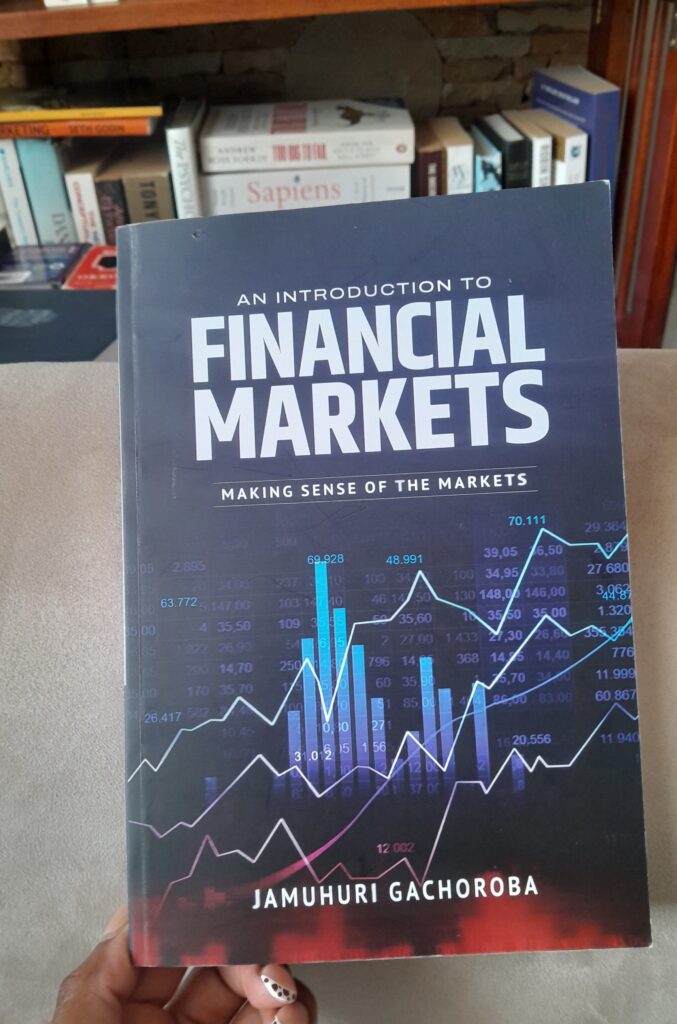Financial markets is an area I have been trying to understand, and it was particularly difficult since I don’t have any background or professional experience in this area. Additionally, majority of the online resources were too complex or filled with endless jargon with little to no explanation.

So, I appreciated how Jamuhuri Gachoroba breaks down the financial markets and its components in layman’s language, so to speak, and without using confusing figures. He also has Did you know sections throughout the book to break down the concepts. At least I can now watch Bloomberg TV without being confused.
The author even explains how the financial markets are involved in our simple day-to-routine, such as in the coffee we take, the fuel we use, and even the vegetables we buy to prepare our food. I also appreciated how he used both local and international examples to provide a wider scope and drive the point home.
An Introduction to Financial Markets: Making Sense of the Markets book has a broad target audience, including university students aspiring to work in this area, people in this profession, and anyone with a general interest in financial literacy, among others.
I came to understand various concepts in the book, so let me narrow down to my top 5 key concepts so that you may also have an opportunity to read the book and discover the other concepts:
1. Cantillon Effect, an uneven change in relative prices resulting from a change in money supply.
2. The Time Value of Money is the concept that money today is worth more than money tomorrow. The reason for that is because money today can be invested to earn interest.
3. Balance Of Trade (BOT) is the difference between the value of a country’s imports and its exports for a given period (usually one year) and is the largest component of a country’s balance of payments (BoP).
4. Volatility Index (VIX): The VIX is the options volatility on the S&P 500 stock index. Also known as the ‘fear index,’ the VIX measures the market’s expectation of volatility over the next 30 days. A higher VIX suggests increased market uncertainty and potentially negative sentiment.
5. The Derivatives Market: A derivative is a financial contract or instrument whose value is derived from the value of an underlying asset. The underlying asset can be a wide range of financial instruments such as stocks, bonds, commodities, currencies, interest rates, and market indexes. Derivatives derive their name from the fact that their value is dependent on or ‘derived’ from the underlying asset. A derivative can be traded either on an exchange or over-the-counter (OTC).
Interesting bonus fact: Did you know there is a bank for central banks? It’s called the Bank for International Settlements (BIS), it was established in 1930 and is headquartered in Basel, Switzerland.
The book has really changed my perspective about how the economy works, how investments work, and most importantly, how the financial markets operate and how they affect my daily routine.
I have also started listening to Jamuhuri Gachoroba’s podcast called The Market Colour: The Market Colour Podcast: Financial Insights and Updates | The Market Colour Podcast to keep myself abreast of the latest developments in the global financial markets.
If you are interested in reading the book, you can get it in Kenya at Nuria bookstore: An Introduction to Financial Markets by Robert Githiri – Nuria Store or internationally from Amazon: Amazon.com: An Introduction to Financial Markets : Making Sense of the Markets eBook : Gachoroba, Jamuhuri: Kindle Store
Quote extracted from the book;
The only function of economic forecasting is to make astrology look respectable ~ John Kenneth Galbraith.
If you found this article insightful, I highly recommend checking out the book reviews section for more thought-provoking content: Book Reviews – Georgina Musembi
Remember to subscribe to my newsletter for free Subscribe – Georgina Musembi for inspiring articles that help you live a better life.

